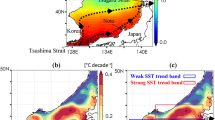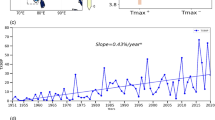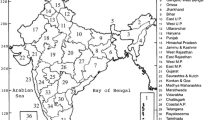Abstract
The characteristics of water vapor transport (WVT) over China and its relationship with precipitation anomalies in the Yangtze River Basin (YRB) are analyzed by using the upper-air station data in China and ECMWF reanalysis data in summer from 1981 to 2002. The results indicate that the first mode of the vertically integrated WVT is significant whose spatial distribution presents water vapor convergence or divergence in the YRB. When the Western Pacific Subtropical High (WPSH) is strong and shifts southward and westward, the Indian Monsoon Low Pressure (IMLP) is weak, and the northern part of China stands behind the middle and high latitude trough, a large amount of water vapor from the Bay of Bengal (BOB), the South China Sea (SCS) and the western Pacific forms a strong and steady southwest WVT band and meets the strong cold water vapor from northern China in the YRB, thus it is likely to cause flood in the YRB. When WPSH is weak and shifts northward and eastward, IMLP is strong, and there is nearly straight west wind over the middle and high latitude, it is unfavorable for oceanic vapor extending to China and no steady and strong southwest WVT exists in the region south of the YRB. Meanwhile, the cold air from northern China is weak and can hardly be transported to the YRB. This brings on no obvious water vapor convergence, and then less precipitation in the YRB.
Similar content being viewed by others
References
Ding Yihui, Hu Guoquan, 2003. A study on water vapor budget over China during the 1998 severe flood periods. Acta Meteorologica Sinica, 61(2): 129–145.
Gao Guodong, Zhai Banmao, 1993. Water vapor transport during two wet/drought summer over the Yangtze River Valley. Advances in Water Science, 4(1): 10–16. (in Chinese)
Hardy D M, Walton J J, 1978. Principal components analysis of vector wind measurements. Journal of Applied Meteorology, 17: 1153–1162.
Kaihatu J M, Handler R, Marmorino G O et al., 1998. Empirical orthogonal function analysis of ocean surface currents using complex and real-vector methods. Journal of Atmospheric and Oceanic Technology, 15: 927–941.
Lu Yurong, Gao Guodong, Zhu Chaoqun, 1996. Study of water climate in droughty/floody years over Yangtze-Huaihe area. Chinese Journal of Geophysics, 39(3): 313–321.
Miao Qiuju, Xu Xiangde, Zhang Shengjun, 2005. Whole layer water vapor budget of Yangtze River Valley and moisture flux components transform in the key areas of the plateau. Acta Meteorologica Sinica, 63(1): 93–99.
Salstein D A, Rosen R D, Peixoto J P, 1978. Modes of variability in annual hemispheric water vapor and transport fields. Journal of the Atmospheric Sciences, 40: 788–803.
Simmonds I, Bi D, Hope P, 1999. Atmospheric water vapor flux and its association with rainfall over China in summer. J. Climate, 12(5): 1353–1367.
Song Zengshan, Yang H, 2001. Vector EOF expansion of summer monthly anomalous wind fields at 500 hPa over East Asia relation to rainfall over China. Chinese Journal of Atmospheric Sciences, 25(3): 401–410.
Wu B Y, Zhang R H, 2006. Distinct modes of the East Asian winter monsoon. Mon. Wea. Rev., 134: 2165–2179.
Xie An, Mao Jiangyu, Song Yanyun et al., 2002. Climatological characteristics of moisture transport over Yangtze River Basin. Quarterly Journal of Applied Meteorology, 13(1): 67–77.
Xu Xiangde, Tao Shiyan, Wang Jizhi, 2002. The relationship between water vapor transport features of Tibetan Plateau-monsoon “Large Triangle” affecting region and drought-flood abnormality of China. Acta Meteorologica Sinica, 60(3): 257–265. (in Chinese)
Zhai P M, Eskridge R E, 1997. Atmospheric water vapor over China. J. Climate, 10: 2643–2652.
Zhang R H, 2001. Relations of water vapor transport from Indian monsoon with that over East Asia and the summer rainfall in China. Advance in Atmospheric Science, 18: 1005–1017.
Zhao Ruixia, Wu Guoxiong, 2007. Water budget for the Yangtze River Basin and evaluation of ECMWF and NCEP/NCAR reanalysis data. Acta Meteorologica Sinica, 65(3): 416–427. (in Chinese)
Author information
Authors and Affiliations
Corresponding author
Additional information
Foundation: International Technology Cooperation Project of the Ministry of Science and Technology of China, No. 2007DFB20210; Application Technology Research and Development Project of Sichuan Province, No. 2008NG0009; Basic Research Foundation of Institute of Chengdu Plateau, China Meteorological Administration, No.BROP2000802
Author: Jiang Xingwen (1983–), specialized in the study of climate diagnosis.
Rights and permissions
About this article
Cite this article
Jiang, X., Li, Y. & Wang, X. Water vapor transport over China and its relationship with drought and flood in Yangtze River Basin. J. Geogr. Sci. 19, 153–163 (2009). https://doi.org/10.1007/s11442-009-0153-6
Received:
Accepted:
Published:
Issue Date:
DOI: https://doi.org/10.1007/s11442-009-0153-6




